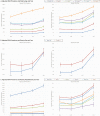National Trends in Pediatric Admissions for Diabetic Ketoacidosis, 2006-2016
- PMID: 33942077
- PMCID: PMC8277205
- DOI: 10.1210/clinem/dgab287
National Trends in Pediatric Admissions for Diabetic Ketoacidosis, 2006-2016
Abstract
Background and objectives: Diabetic ketoacidosis (DKA) rates in the United States are rising. Prior studies suggest higher rates in younger populations, but no studies have evaluated national trends in pediatric populations and differences by subgroups. As such, we sought to examine national trends in pediatric DKA.
Methods: We used the 2006, 2009, 2012, and 2016 Kids' Inpatient Database to identify pediatric DKA admissions among a nationally representative sample of admissions of youth ≤20 years old. We estimate DKA admission per 10 000 admissions and per 10 000 population, charges, length of stay (LOS), and trends over time among all hospitalizations and by demographic subgroups. Regression models were used to evaluate differences in DKA rates within subgroups overtime.
Results: Between 2006 and 2016, there were 149 535 admissions for DKA. Unadjusted DKA rate per admission increased from 120.5 (95% CI, 115.9-125.2) in 2006 to 217.7 (95% CI, 208.3-227.5) in 2016. The mean charge per admission increased from $14 548 (95% CI, $13 971-$15 125) in 2006 to $20 997 (95% CI, $19 973-$22 022) in 2016, whereas mean LOS decreased from 2.51 (95% CI, 2.45-2.57) to 2.28 (95% CI, 2.23-2.33) days. Higher DKA rates occurred among 18- to 20-year-old females, Black youth, without private insurance, with lower incomes, and from nonurban areas. Young adults, men, those without private insurance, and from nonurban areas had greater increases in DKA rates across time.
Conclusions: Pediatric DKA admissions have risen by 40% in the United States and vulnerable subgroups remain at highest risk. Further studies should characterize the challenges experienced by these groups to inform interventions to mitigate their DKA risk and to address the rising DKA rates nationally.
Keywords: diabetic ketoacidosis; disparities; pediatrics; type 1 diabetes.
© The Author(s) 2021. Published by Oxford University Press on behalf of the Endocrine Society. All rights reserved. For permissions, please e-mail: journals.permissions@oup.com.
Figures



References
-
- Dhatariya KK, Glaser NS, Codner E, Umpierrez GE. Diabetic ketoacidosis. Nat Rev Dis Primers. 2020;6(1):40. - PubMed
-
- Liu CC, Chen KR, Chen HF, Huang HL, Ko MC, Li CY. Trends in hospitalization for diabetic ketoacidosis in diabetic patients in Taiwan: analysis of national claims data, 1997–2005. J Formos Med Assoc. 2010;109(10):725-734. - PubMed
-
- Zhong VW, Juhaeri J, Mayer-Davis EJ. Trends in hospital admission for diabetic ketoacidosis in adults with type 1 and type 2 diabetes in England, 1998–2013: a retrospective cohort study. Diabetes Care. 2018;41(9):1870-1877. - PubMed
-
- Desai D, Mehta D, Mathias P, Menon G, Schubart UK. Health care utilization and burden of diabetic ketoacidosis in the U.S. over the past decade: a nationwide analysis. Diabetes Care. 2018;41(8):1631-1638. - PubMed
Publication types
MeSH terms
Grants and funding
LinkOut - more resources
Full Text Sources
Other Literature Sources
Research Materials

